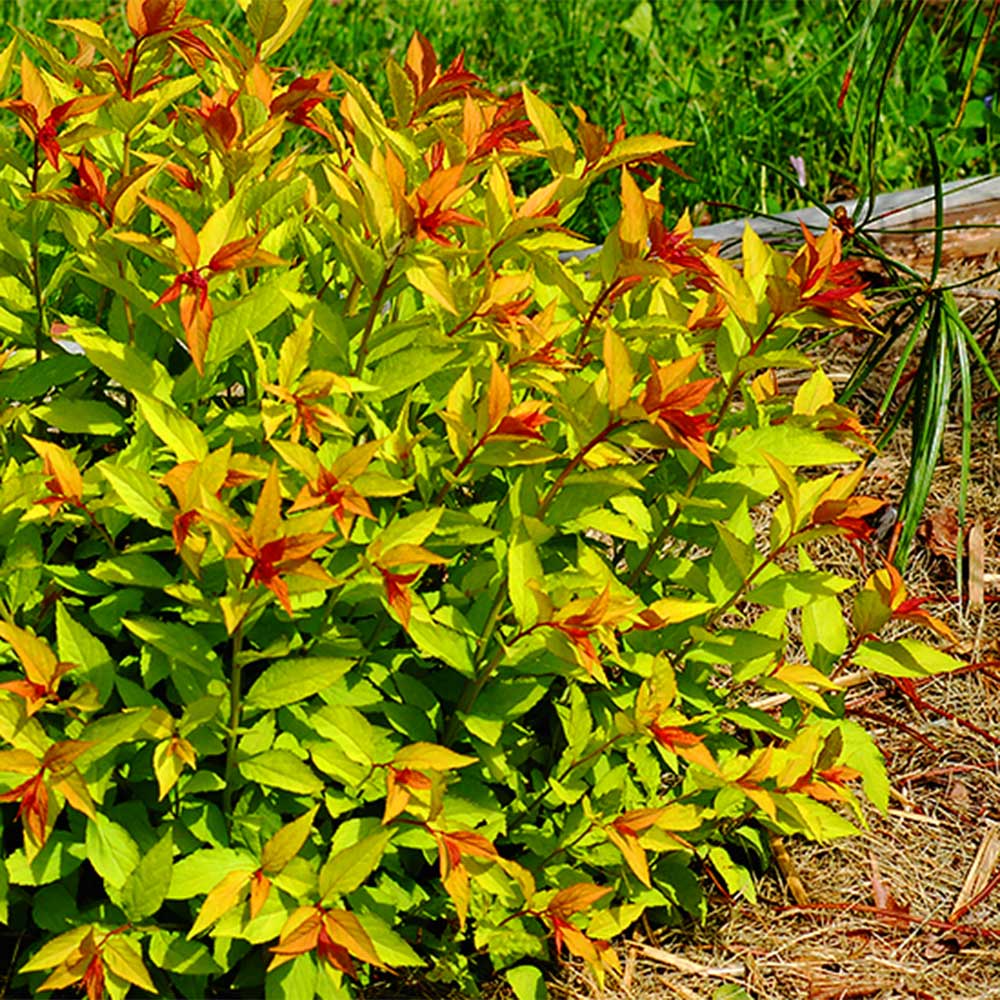Riverdene Garden Center
Goldflame Spirea
Goldflame Spirea
Couldn't load pickup availability
Spiraea japonica ‘Goldflame’
Goldflame Spirea is a compact, deciduous shrub known for its stunning foliage that transitions from bronze-red in spring to bright yellow-green in summer and fiery orange-red in fall. It also produces clusters of vibrant pink flowers in early summer. This cold-hardy (Zone 3-8), drought-tolerant, and easy-care shrub is perfect for borders, mass plantings, foundation plantings, and hedges in Southwest Saskatchewan.
Planting & Location
- Hardiness Zone: 3-8 (extremely winter-hardy and suitable for prairie climates)
- Mature Size: 3-4 feet tall, 3-4 feet wide
- Growth Rate: Moderate to fast (12-24 inches per year)
- Sunlight Needs: Full sun to partial shade (best foliage color in 6+ hours of direct sunlight)
-
Soil Preference:
- Prefers well-drained, loamy soil.
- Tolerates clay, sandy, and slightly alkaline soils.
- Avoid waterlogged soil—Goldflame Spirea does not tolerate excessive moisture.
- Spacing: 3-4 feet apart for mass planting, 4+ feet apart for individual shrubs.
Watering
- Young Plants (First Year): Water deeply 1-2 times per week to establish roots.
- Established Shrubs: Drought-tolerant; water every 2-3 weeks in dry conditions.
- Avoid Overwatering: Prefers moderate soil moisture, but allow the soil to dry slightly between waterings.
Fertilizing
- First Year: No fertilizer needed—focus on root establishment.
-
Mature Shrubs:
- Apply a balanced slow-release fertilizer (e.g., 10-10-10) in early spring to encourage growth and flowering.
- Organic alternative: Compost or well-rotted manure in spring.
Pruning & Maintenance
- Best Time to Prune: Late winter to early spring, before new growth starts.
-
How to Prune:
- Remove dead, diseased, or weak branches to encourage fresh growth.
- Cut back by one-third in early spring to maintain a compact, bushy shape.
- Deadhead spent flowers to encourage a second flush of blooms in late summer.
Flowering & Foliage
- Bloom Time: Early summer (June-July), with possible reblooming in late summer if deadheaded
- Flower Color: Clusters of vibrant pink flowers
-
Foliage:
- Spring: Bronze-red new growth
- Summer: Bright yellow-green leaves
- Fall: Fiery orange-red foliage for seasonal contrast
Pest & Disease Management
Resistant to: Deer, drought, and urban pollution
Common Pests:
-
Aphids – May cause curled leaves and sticky honeydew.
- Solution: Spray with insecticidal soap or introduce ladybugs.
-
Spider Mites – Can cause yellowing or speckled leaves in dry conditions.
- Solution: Hose off with water or use insecticidal soap.
Common Diseases:
-
Powdery Mildew – White fungal coating on leaves.
- Solution: Improve airflow and apply fungicide if needed.
-
Leaf Spot (Fungal or Bacterial) – Causes brown spots on foliage.
- Solution: Avoid overhead watering and remove infected leaves.
Winter Protection
- Highly winter-hardy—no special protection needed.
- Mulching: Apply 2-4 inches of mulch around the base (not touching the stems) to insulate roots.
- Pruning in Late Winter: Cutting back in early spring will promote fresh, colorful growth in the new season.
Landscape Uses
Great for low hedges, borders, and foundation plantings
Compact and low-maintenance—perfect for small gardens
Seasonal color with bronze, yellow, and red foliage
Deer-resistant and adaptable to various soil types
Attracts butterflies and pollinators
Additional Notes:
- Goldflame Spirea is one of the most colorful, versatile spirea varieties, offering multi-season interest with its changing foliage and pink blooms.
- Lifespan: 20+ years with proper care.
- Works well in rock gardens, cottage gardens, mass plantings, or as a focal shrub.
Photo courtesy of Foothills Nursery
Share


